Looking for information on the angel’s landing hike? Here’s everything you need to know!
One last step forward and the largest sky opens up to the most astounding sight. For a moment, everything seems to pause. I breathe out the breath I didn’t realize I was holding on to for probably the last two hours. This is the top, this must be where the Earth meets the sky.
With views in all directions, it’s hard to decide what to admire first. The winding Virgin River so far below us snakes its way through the canyon floor, trailing off into the distance.
The massive cliffs that line the sides of the canyon stretch for miles erupting with layers upon layers of sandstone creating a water color mixture of reds, browns, and grays. It seems as though the cliffs moved to the side to accommodate anyone who dared to summit this peak. As if to say, “This is what we have in Utah, try and top this view somewhere else.”
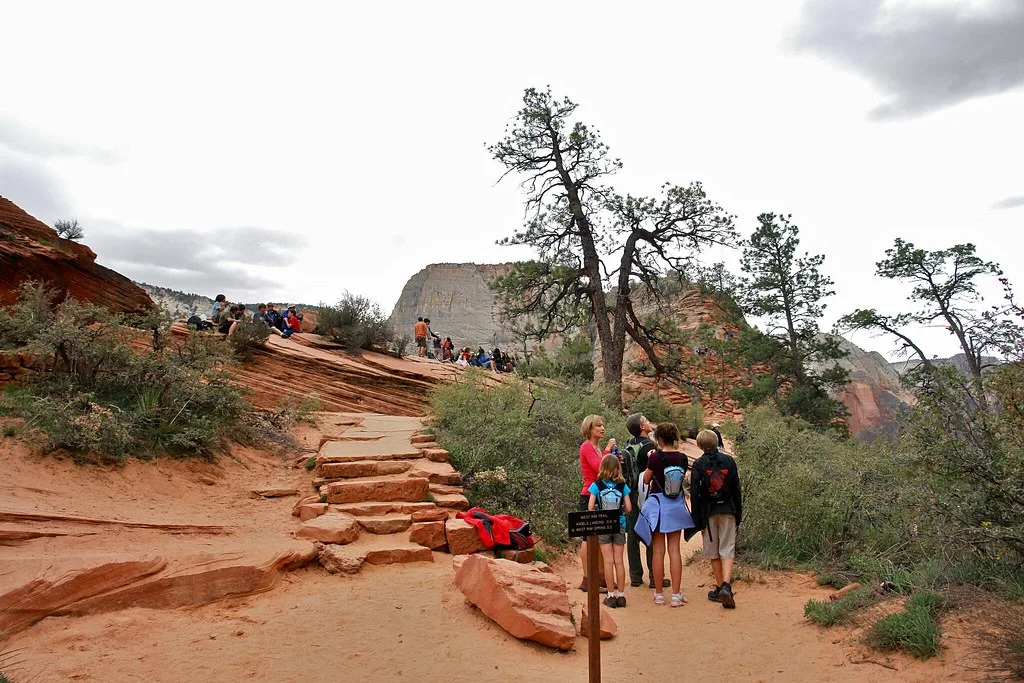
Angel’s Landing Hiking Guide/ Flickr
The Angel’s Landing trail is one of the most popular hikes in the National Parks system. The jaw dropping views coupled with the mental challenges along the journey make the hike one that is hard to forget. If you can stomach steep drop offs, rigorous inclines, and adrenaline rushes, this hike is for you!
Note: Angel’s Landing is not a short easy trail in Zion but it is well worth the effort!
This guide contains the following contents:
- Information about Angel’s Landing
- Necessary precautions
- Planning beforehand (permits)
- Day of tips
- What to expect on the trail
1) Information about Hiking Angel’s Landing
The total distance: 5.4 miles
Difficulty: Strenuous
Angel’s Landing Hike Length: 3 to 5 hours
Best time to hike: November and May to miss peak times, but it’s open year round
Angel’s Landing Elevation: 1,500 feet
Other Zion Hikes you might like: The Narrows; Emerald Pools
2) Necessary precautions for the Angels Landing Hike
This hike is not for anyone who has a fear of heights. The final ascent is also known as the “spine” because it has many very thin sections of trail supported with a chain.
Considering the fact that for about half a mile, hikers ascending and descending are using the same path to go in opposite directions. It can be very anxiety producing. Oftentimes, hikers need to pause in precarious positions to allow the hikers going in the opposite direction to pass by them.
If the hike is really busy (which hopefully with the help of permits is limiting the numbers), hikers may find themselves feeling uneasy with the use of the chains as well. When many people are holding on to the same part of the chain, ironically, holding the chains may create a less stable situation.
The chain moves slightly with each passing hiker. At times, holding on to the rock itself was more comforting.
Another aspect to be cautious of is going down. Many focus on reaching the summit as the goal. However, descending the narrow, chain section is almost more challenging than going up it.
There is a lot of sliding, scrambling, and very cautious foot placement necessary all while looking down at the canyon below. This is the portion of the hike that mental focus is even more important. There should be limited daydreaming or celebrating with the recent accomplishment of reaching the top. Looking carefully at each spot to plan each step is a priority.
If someone has physical challenges, they should consider their own limitations when deciding if this hike is appropriate.
The good news is there are many spectacular sights along the way, so staying within someone’s physical abilities can certainly be met with the different legs of the hike. If at any point the hike becomes too strenuous, the path down is the same as going up.
Lastly, as a safety measure, there are all different types of hikers in terms of experience that will attempt the final ascend to the summit. There may be very experienced hikers who have no problem with heights moving quickly throughout the last half a mile on the “spine”. There may also be individuals who rarely hike and seem overly-cautious in the last portion of the hike. Be cognizant of these differences when using the same path that goes up and down. Plan on pulling over especially if you travel at a slower pace to accommodate those who move faster.
See more: Best hotels near Zion National Park
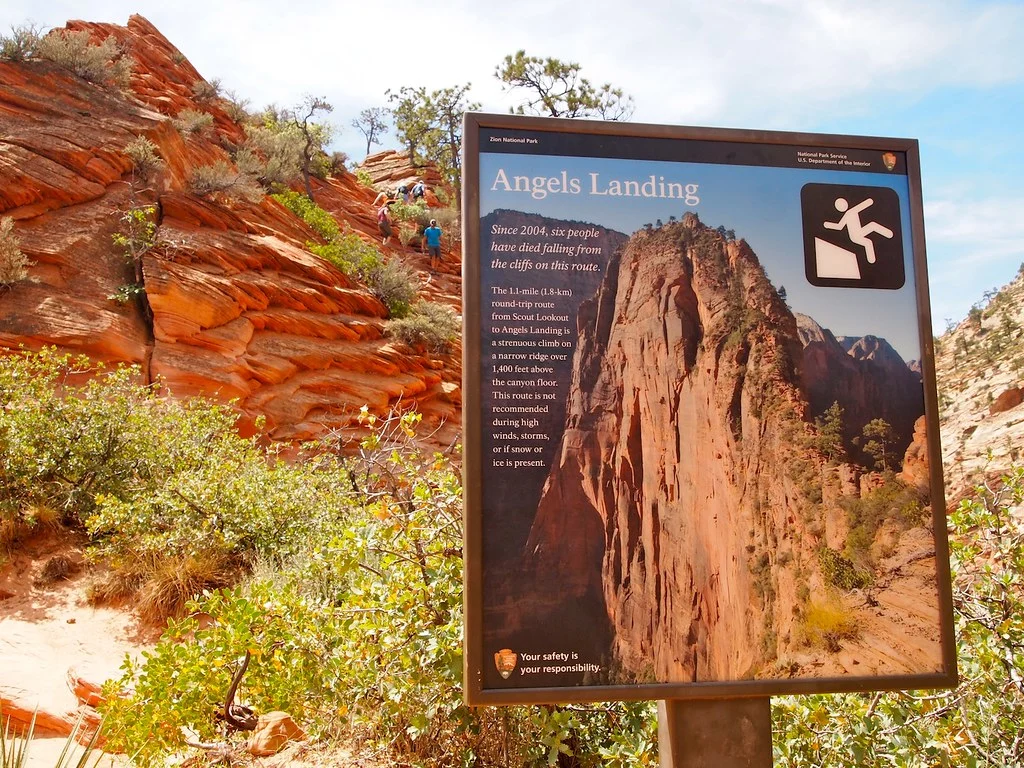
Necessary precautions/ Flickr
3) Planning beforehand
Currently, the National Park Service requires all hikers to have a permit to hike Angel’s Landing. There are park rangers monitoring this in a couple locations along the way. The popularity of this hike has increased over the years.
In an effort to keep lines from forming along the chains, permits have been in effect. When I hiked Angel’s Landing, there were no permits. There were long lines along with more experienced hikers that were behind us, pushing us to go at a faster pace than we were comfortable. Needless to say, limiting the number of people creating congestion where there are sections a foot or two wide seems helpful.
It’s relatively easy to get a permit. Click on the Recreation.gov website. There are links for the seasonal lottery. This gives you an opportunity to choose a range of dates along with the time of day to hike. Keep in mind, the earlier time frames to hike will yield fewer hikers. If the seasonal lottery doesn’t work out, I’ve heard the day-before lottery works well as a back up.
It may actually work out better to attempt the day-before lottery than planning months in advance. Monitoring the weather and other factors may help to make a more informed decision on the best day. It costs $6 to submit an application. If you are chosen to hike Angel’s Landing, you will automatically be charged an additional $3 per person.
What to do outside of the park: Things to do near Zion National Park
4) Day-of Tips
Shuttle Information:
All of a sudden, the day is here! Be mindful of the shuttle schedule to and from Angel’s Landing (stop #6 The Grotto). A shuttle will take hikers to various hikes around Zion. The return trip to the visitor’s center is something to consider.
It would be almost five miles to walk back from the Angel’s Landing trail to the visitor’s center if the last shuttle is too full or is missed.
With Angel’s Landing being so popular, it’s wise to get to the shuttle with plenty of time to spare. There’s a chance the first one will fill up quickly. Since there’s no reservation for the shuttles, it’s first come first serve. The shuttle doesn’t cost anything.
Most people take the shuttle from the visitor’s center. My husband and I took the Springdale shuttle line from where we were staying to the visitor’s center to hop onto a shuttle in the Zion Canyon Line. We waited in a long line at the visitor’s center for the next available shuttle, we even got there before 7am in hopes to catch the first bus out. Plan to get there early if this is also your plan. I’ve heard that Angel’s Landing has become even more popular since we visited there in the summer of 2016.
What to pack:
Plan to bring a lot of water (especially if it’s summer time). We hiked it when there was a 107 degree heat advisory. We brought two liter bottles that fit in a small hiking backpack. Some hikes I’ve found myself on, I could get away with gym shoes.
This hike is challenging. Hiking boots that support the ankles are important. Hiking poles may also be helpful. Bring snacks.
Factoring in the time spent waiting for a shuttle, driving to and from the trailhead, not to mention actually hiking Angel’s Landing there’s a good chance you’ll get hungry. There are no drive-thrus or snack shops in the midst of Zion Canyon.
5) What to expect on the trail
I’d be lying to you if I said I wasn’t nervous. My husband and I spent quite a lot of time discussing this hike before we trekked out west. It was the one part of the four week road trip we were on that really caused me some anxiety.
I wish I could tell you that I was able to put a pin in my fears to enjoy the beauty of the canyon as we embarked on the first part of a journey that would change my life. Unfortunately, much of the early part of the hike my mind was cluttered with doubt.
The start of the trail began with a paved, somewhat level path. Crossing over the Virgin River was one of the first aspects to the trail. Almost immediately, the Angel’s Landing cliff jumped to the foreground, inviting us forward. The surrounding cliffs formed the walls of a basin accentuating the colossal sandstone concoction waiting to be tackled.
West Rim Trail
This portion of the West Rim Trail offered many diverse sections. It started off by the river and slowly migrated closer and closer to one of the walls of the canyon. There was plenty to marvel at as the path started to elevate. There was also plenty to question as the path became more rigorous. Would I be able to do this? What if I didn’t have it in me?
A handful of switchbacks increased the altitude quickly, and distracted me from my questions. This was the first real uphill challenge. We took many breaks. My husband and I love adventures. We are average hikers, breaks were necessary. The day was also starting to warm up, good thing for all that water we brought! With each turn, we were steadily climbing up the canyon wall. The views of the canyon were incredible. To think that we had only just begun and there was so much to appreciate already, inspired me to keep moving.
We headed along a cliff with such a spectacular view, for a second I forgot about the rest of the hike. The view seemed worthy of a hike all by itself. There we were looking down on all the switchbacks and the canyon floor we had just traversed. Had we just climbed up all this way? Did we really start that far down? I couldn’t believe how far we had already come. The start of the trail curved far off in the distance. It felt like a balcony part-way up a castle overlooking a sandstone village. My confidence started to rise. If I could make it this far up and attain such an incredible view, I can only imagine what the rest of this climb will share.
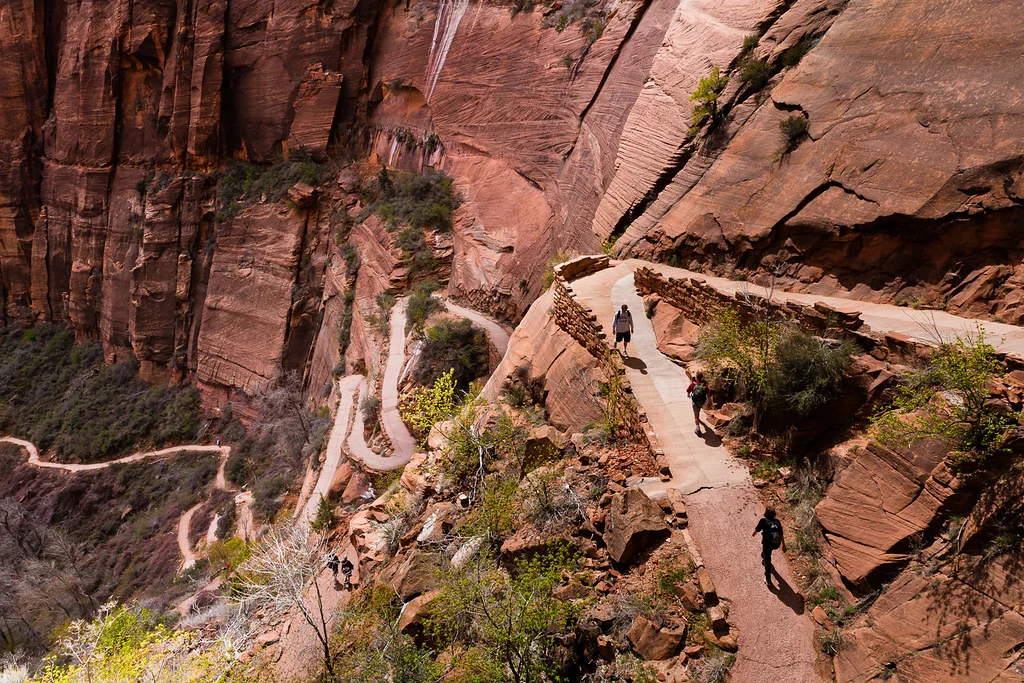
Angel’s Landing Switchbacks – West Rim Trail/ Flickr
Refrigerator Canyon
Next, we entered Refrigerator Canyon. This was a welcome relief from the heat and the sun. This shady portion of the trail came at just the right time. We took a break and chatted about the first stretch and how tired our legs were feeling. Little did we know what was to come next.
My anticipation resurfaced as we surveyed the next set of challenges. Walter’s Wiggles. We were at the bottom of the tightest, steepest switchbacks I had ever seen. Whoever created this stretch of the trail must have thought the earlier switchbacks were far too stretched out. It was time to get right to the point. If we were going to reach the pinnacle of Angel’s Landing, we’d better start climbing up. The switchbacks started and my thighs began to burn. Every step felt like a race in the highest setting of an elliptical machine. The sun was back in full force. We took a break and then another one, and another one. Just make it up one more incline, I thought. There were 21 pulse-pumping switchbacks. Ironically, the most physically challenging part of the trail was behind us as we climbed the last incline.
What came next was a mental challenge more than anything else.
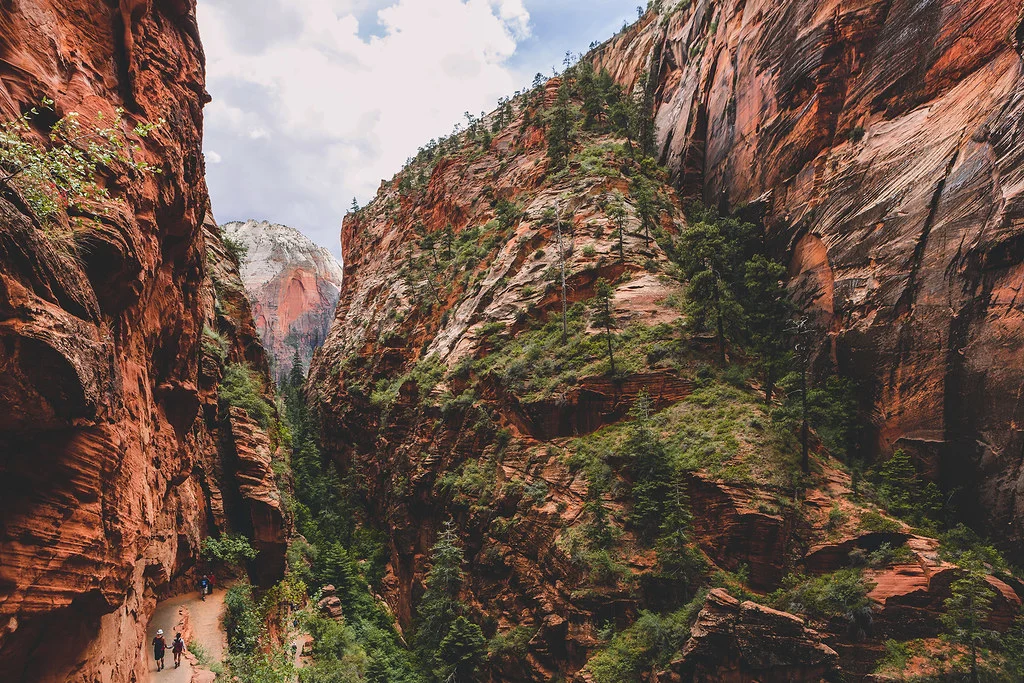
Refrigerator Canyon/ Flickr
Scout’s Lookout
The first real spotting of the highly anticipated trail leading to the summit was upon us, Scout’s Lookout. Panic shot through me as I looked at what can only be described as a thin, questionable trail at best. My nerves kicked in.
We were getting close, but this was the part that would be tough to stomach. From the beginning, my husband and I had agreed that we’d get to this point and decide if we had it in us to keep going. It was intimidating to say the least, especially the first part. The paved path was long gone. I didn’t realize how grateful I should have been for that paved path until it disappeared into slanted boulders and make-shift steps leading vicariously up.
In some portions, the only resemblance of a trail was the chain. Some places along the sandstone brown backdrop, I could see dots of color where people were moving along the path. Are we really doing this? The debate was on. We watched for a bit as others started the first portion of the spine. Picture that man-made bridge in Indiana Jones. You know the one he slices the bridge so it collapses? That’s about what the spine looked like. Of course the rocks weren’t going to collapse. However, It was just as precarious and maybe even more narrow.
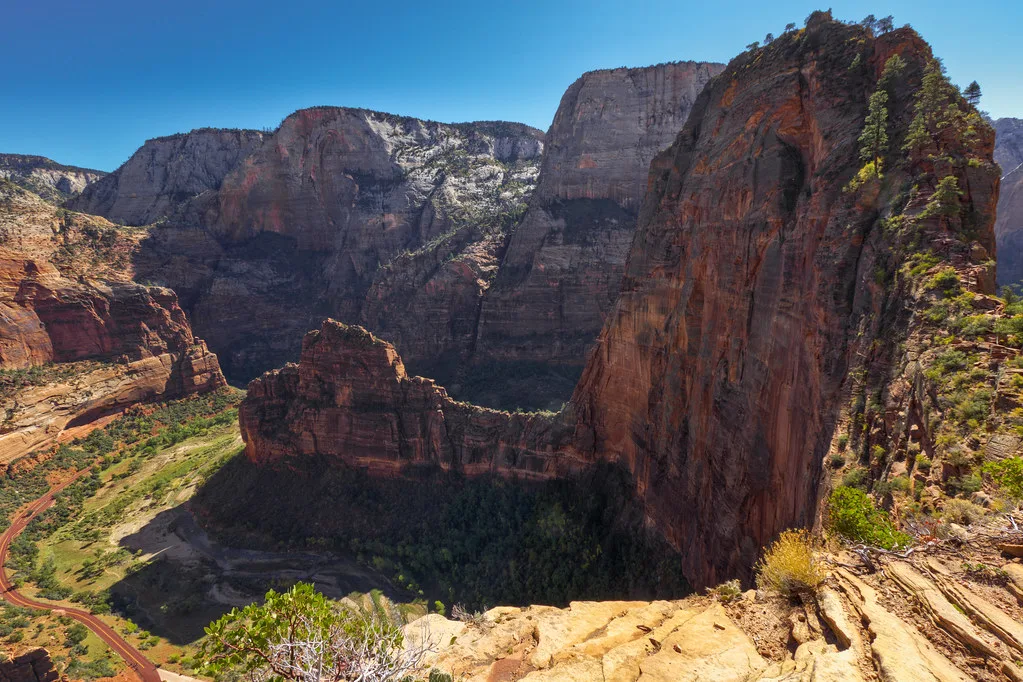
Scout’s Lookout/ Flickr
At some point I realized that watching others was making it more difficult to consider moving past Scout’s Lookout. Did we really come all this way to stop short of the ultimate goal?
Somehow, someway, I found it within myself to agree to the next stretch. This required quite a bit of mental strength. The first part was like an initiation to the next half mile of challenging foot placements. I guess I shouldn’t have been surprised that there was such a steep incline. After all, we were climbing a strenuous cliff leading up 1,500 feet. However, the sandstone tipped alarmingly at a frightening angle. There was no chain. No direct path. I had gone indoor rock climbing before. This first part felt like I was rock climbing, but the stakes were incredibly high considering we had no gear, nothing securing us to this mountainous wall, and let’s not forget about the thousand foot drop just footsteps away. The only security was in my own feet, my hands clutching on to what seemed like the best route, and my mind telling me that I could do this.
I told myself I could do this one step at a time. One step. The next one. Some “steps” weren’t steps as much as they were scaling angled rock formations. There wasn’t one right way to approach each section. Whatever could be stomached.
We moved slowly, carefully, methodically through each small section. I didn’t dare look too far to the left or right, or let my mind wander. I focused on looking at each rock I planned to put my foot on. Many times we had to freeze where we were so people could work their way around us. Some of those times we were the ones letting go of the chains for a moment to move around people going down. The hike was starting to get more crowded, which meant more cautious maneuvers around fellow adventure-seekers.
We made it to another landing strip. This was just another spot where we could breathe with more space. Looking ahead, we could finally see the path to the top. Were we really considering turning around now? How could we? We couldn’t! We made it this far, there was no turning back now.
I braced myself for more focused foot placements and tried not to think about how far down it could have been. At one point, there was no chain. Just a ledge of rocks guiding us on one side. The other side had nothing, but sheer drop-offs. With each breath-holding moment, it seemed I was getting more comfortable being uncomfortable. There were so many obstacles. My mind couldn’t have been more focused on each awkward rock jutting into our path.
And then there was a plank on its own ledge maybe a foot wide with nothing on either side. An earlier version of myself would have been terrified. I walked across the precarious rock thankful for this new found confidence. The slabs of brown and red rock carried me from one unsettling circumstance to a new, tenacious adventure.
I looked up and saw a final cliff that required both hands maneuvering up the chains, stretching up the giant steps, and a few more miraculous hair-raising moments. At the culmination of that cliff, the rocks leveled off in what seemed like slabs of sandstone angled down like shingles tattooed to a roof. Momentum grew knowing how much I had just tackled physically, but especially mentally. I walked with my husband across the last threshold before reaching the final platform.
The sun shone bright as the surreal world at the top came into focus. There was no complaint for the sun shining now. It painted this panoramic view with the most beautiful colors and textures, and let’s not forget about the sky.
The sky stretched on for miles and miles. It’s as though we could see all of Zion from this one look out. We could look back at the path we had just scaled. We could see where we embarked on this journey so far down in the canyon. Most of all, I saw myself and my husband in a new light. What an incredible day this had been. I felt like I was on top of the world, and I quite literally was.
We absorbed the magnificent view as much as we could. A welcome time to stay in the present. I knew just how much I had overcome to lay claim to this view, it was monumental.
Going down Angel’s Landing
Soon it was time to go down. Going down Angel’s Landing was another challenge within itself. We found ourselves sliding and scrambling as we faced the same path from a different angle.
Our trip back down to the canyon floor led us to the Virgin River. Elated, we found ourselves cooling off in the river to celebrate such a life-changing hike. I have my husband to thank for encouraging me to step outside my comfort zone. I left Zion a changed person with a new perspective on nature, challenges, and myself.
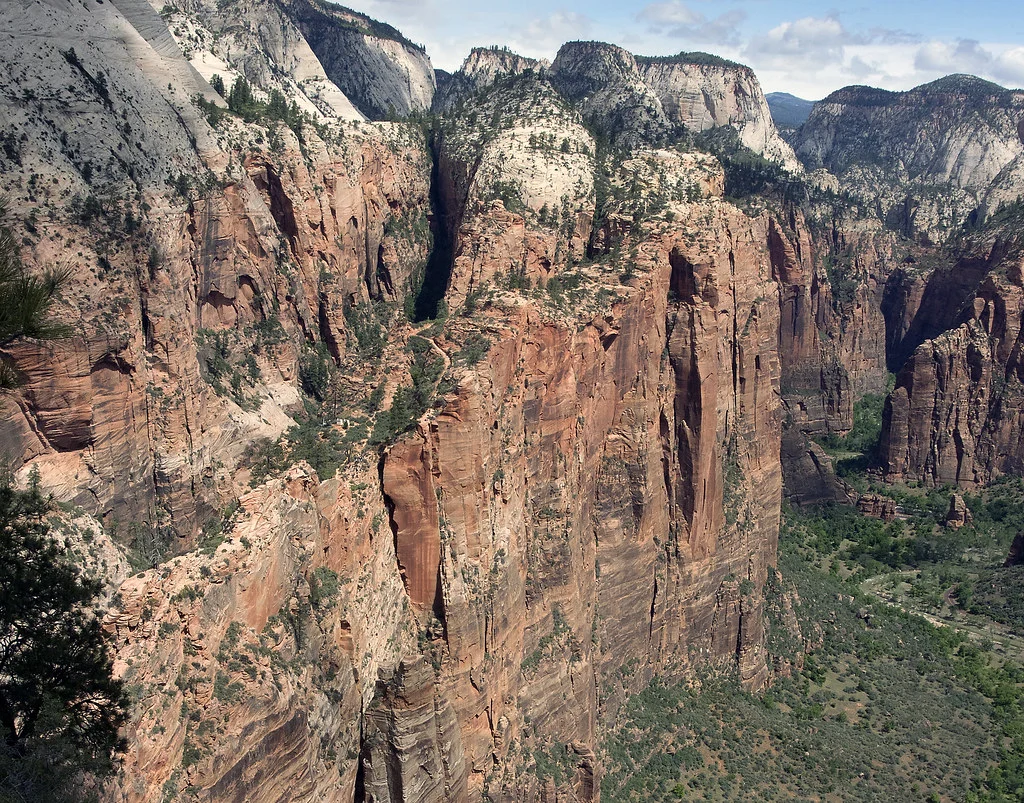
Angel’s Landing Deaths – The Danger of Hiking it
In the last 20 years, at least 14 people have died attempting to hike Angel’s Landing. Hiking Angel’s Landing is not for the faint of heart and does come with a certain level of risk.
We would not recommend going on this hike if you are scared of heights or uneasy on your feet.
****
See more:

